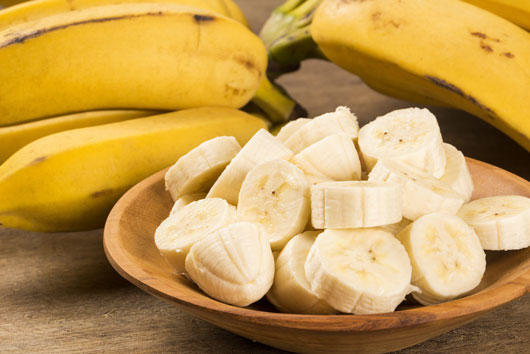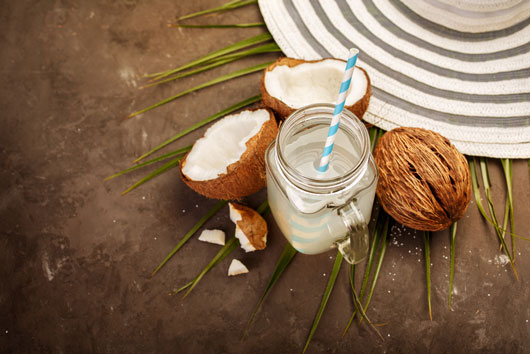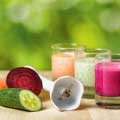
UPDATED June 17th, 2017
You always hear people talk about electrolytes and the fact that you need to properly manage the levels of electrolytes in your body—but you seldom hear about food with electrolytes. When you’re dehydrated, you need more electrolytes. When you’re low on energy you’re probably lacking electrolytes. And sure, they sound important. But what are these things and why do you even need them? It’s not really a simple term to define, unless you’re a biology pro, and then it will probably make a lot of sense to you. But in basic terms, our bodies function thanks to the complex network of cells, tissues and fluids that work together by the conduction of electrical impulses, and this communication, as per Built Lean, is “only possible because those cells, tissues, and fluids thrive in a homeostatic environment where they conduct electricity well enough to carry the signals to their intended destinations.” See, it’s kinda confusing. Let’s see if we can simply it a bit more…According to Merriam-Webster, an electrolyte is “any of the ions (as of sodium or calcium) that in biological fluid regulate or affect most metabolic processes (as the flow of nutrients into and waste products out of cells).”
Ok, so the basic takeaway is that electrolytes in our body are really important in making sure that we are able to function at maximum capacity in all aspects of physical activity. Which is why when you are working out you are constantly told to replenish your electrolytes. But how do you get these electrolytes into your body? While we all assume sports drinks are the only answer (false!), there are wholesome, less-obvious options as well. Here are 5 new foods with electrolytes so you can feel your best and your body can function at peak performance.
Read Related: Side Effects of Energy Drinks: 7 Reasons You Need to Ditch It Now

1. Peanut Butter or Almond Butter on a Bagel – for Sodium
Sodium is an important electrolyte because it regulates the amount of water in the body and helps maintain muscle and nerve function. While most people consume enough salt each day to have a healthy level of sodium in their body—in fact, we’re often told to stay away from too much sodium—when you rehydrate and drink too much water, without enough sodium your electrolyte levels drop which can cause problems including muscle spasms, fatigue and headaches. The best way to increase sodium intake is to eat healthy snacks and foods that are naturally high in sodium. That doesn’t mean load up your food with table salt. It does mean you can eat a bagel with peanut butter or almond butter, which provide healthy amounts of electrolytes (sodium) as well as protein and healthy fats to boost performance and energy levels.

2. Bananas, Dried Fruit or Kale Chips – for Potassium
Another key electrolyte needed for a healthy body is potassium, which regulates your PH balance and maximizes cell and muscle function. When your electrolytes are low you’ll feel sluggish, achy and weak; you’ll probably also feel starving and parched. Bananas are a great way to replenish your electrolytes (and quench your appetite) because they are loaded with potassium. “One medium fruit does pack more than 400 mg of this heart-healthy mineral. But bananas are also the ultimate hunger buster, packed with Resistant Starch, a healthy carb that fills you up and helps to boost your metabolism,” reports Health.com. If you don’t have any bananas handy or you happen to hate this fruit, then you can choose dried fruits such as prunes, dried apricots or raisins. Another great source of potassium are leafy green veggies like kale or spinach. If you’re looking for a quick snack, pop a few baked kale chips and you’ll be set.

3. Greek Yogurt or a Bowl of Cereal with Milk – for Calcium
Calcium isn’t just crucial for healthy bones; it’s also a big source of electrolytes and a great way to ensure your muscles and bones are working properly and protected for the future. In fact, “researchers at McMaster University in the UK found that the calcium-rich beverage does a better job than water or sports drinks at rehydrating the body after a workout.” A glass of milk, a bowl of cereal or a Greek yogurt are all excellent options (they’re high in protein too, a major perk). And if you are intolerant to lactose there are options for you as well. You can opt for almond milk, soymilk, dairy-free cheese or tofu.

4. A Handful of Nuts (Think Almonds or Walnuts) or Beans – for Magnesium
Magnesium plays a HUGE role in promoting proper cell function, as well as nerve function, the formation of bones and the synthesis of DNA. Aka, it’s a big deal. When magnesium levels dip and you’re running low on electrolytes you can experience numbness, exhaustion, muscle spasms and more. Nuts are high in magnesium, and they are also a good source of healthy fats and protein. Beans are also a great go-to food to replenish electrolyte levels; add some chickpeas or black beans to your salad or sandwich, or eat some multi-grain crackers and hummus for a quick snack.

5. Coconut Water or Electrolyte-Infused Water
Lastly, instead of drinking a sports drink that is loaded with added sugar and artificial flavors, grab a coconut water or water that is infused with electrolytes, such as Propel. Coconut water is a great source of electrolytes because it has “natural salts, especially potassium and magnesium” while also being nearly fat free and packed with other antioxidants and nutrients.











